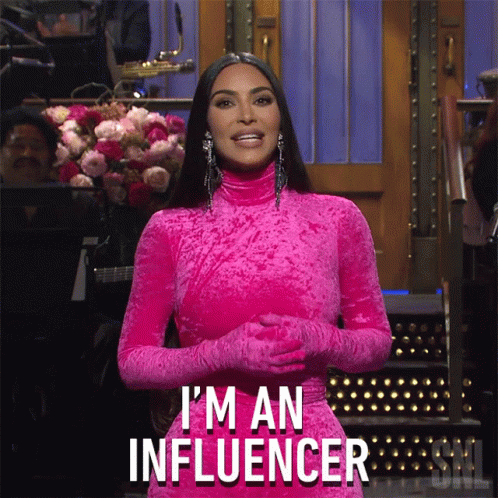Definition Of Influencer Marketing
These individuals, known as influencers, have established credibility and a dedicated following on platforms such as Instagram, YouTube, or TikTok.
By partnering with influencers, brands can tap into their engaged audience, increasing brand visibility, driving conversions, and ultimately, boosting sales.
Influencer marketing campaigns typically involve the creation of content, such as social media posts or videos, that showcases the brand or product organically and authenticallyBrands need to establish.
This form of marketing has gained significant traction in recent years, becoming an essential component of many brands' marketing strategies to effectively reach their target audience.
Benefits Of Influencer Marketing
Influencer marketing has quickly become a powerful tool in the digital marketing landscape, delivering numerous benefits for brands looking to connect with their target audiences effectively.
By partnering with influencers who have established credibility and a loyal following, businesses can reach their desired demographic directly and build trust with consumers.
One of the primary advantages of influencer marketing is its ability to tap into an influencer's established audience, which often consists of individuals who share similar interests or values.
This targeted approach guarantees that brands can reach the right people, maximizing the impact of their marketing campaigns.
Furthermore, influencers are known for their authenticity, which sets them apart from traditional advertising methods.
Consumers are more likely to trust recommendations from influencers they follow and respect, making influencer marketing an effective way to build trust and enhance a brand's reputation.
By collaborating with an influencer, brands also gain access to their loyal following.
These followers engage with the influencer's content regularly, resulting in high levels of engagement for branded campaigns.
This direct connection with a dedicated audience provides brands with a unique opportunity to generate buzz around their products or services.

Challenges Of Influencer Marketing
While influencer marketing offers numerous benefits, it is not without its challenges. One major concern is the potential risk of influencer content not aligning with a brand's image.
With influencers having control over the content they create, there is a possibility that their posts may not accurately represent the values or messaging of a brand.
This can lead to a disconnect between the brand and its target audience, damaging its reputation and credibility.
Another challenge in influencer marketing is the prevalence of fake followers. Some influencers resort to purchasing followers or engagement to appear more influential than they are.
This not only deceives brands but also undermines the effectiveness of influencer marketing.
Building trust between brands and influencers is vital for successful influencer marketing campaigns.
However, maintaining this trust can be challenging, especially when working with young influencers who may lack experience and business acumen.
Brands need to establish clear guidelines and communication channels to make sure that the content created by influencers aligns with their expectations and brand identity.
Types Of Influencers
There are various types of influencers in the world of influencer marketing, each with its unique characteristics and audience reach.
Macro influencers, for instance, are those with a massive following, often in the millions, and are typically celebrities, industry experts, or well-known personalities.
They have the power to reach a large audience and can greatly impact brand visibility.
On the other end of the spectrum, we have micro-influencers, who may have a smaller following, but have higher engagement rates and tend to focus on niche topics.
These influencers may have a closer connection with their audience and can be seen as more relatable.
There are also nano-influencers, who have a small but dedicated following and can be highly influential within their specific communities.
Lastly, there are social influencers, who have a significant presence on social media platforms and can leverage their large following to promote brands and products.
Understanding the different types of influencers is crucial for brands to identify the best fit for their influencer marketing strategies and target the right audience effectively.

Micro-Influencers
Micro-influencers are an asset in influencer marketing campaigns, thanks to their ability to connect with a highly engaged audience.
Unlike macro-influencers who have millions of followers, micro-influencers typically have a smaller audience size range, ranging from a few thousand to a hundred thousand followers.
Collaborating with micro-influencers has its benefits. Their smaller audience size allows for more personalized and targeted content, resulting in higher engagement rates.
Micro-influencers also tend to have a more authentic and relatable presence on social media, making them appear more trustworthy to their audience.
Another advantage of working with micro-influencers is their cost-effectiveness. Since they have smaller follower counts, they often charge lower rates compared to mega-influencers.
This allows brands to reach their target audience without depleting their entire influencer marketing budget.
Mega-Influencers
Mega-influencers, in contrast to micro-influencers, have a substantially larger follower count, often exceeding the 1 million mark.
This massive audience provides a significant advantage for brands looking to reach a broad range of demographics. With their vast reach, mega-influencers can expose your brand and its offerings to millions of people.
One of the key benefits of partnering with mega-influencers is the potential to tap into a diverse audience base. Their followers span a wide range of ages, interests, and locations, allowing brands to target a broader market.
This expansive reach can be particularly advantageous for product launches or campaigns aimed at reaching many potential customers.
However, working with mega-influencers comes with its drawbacks. Due to their popularity and high demand, mega-influencers often command higher fees compared to their micro-influencer counterparts.
This can significantly impact a brand's influencer marketing budget.
Additionally, despite their large follower count, mega-influencers may experience lower engagement rates compared to micro-influencers.
This can be attributed to the difficulty of building personal connections and fostering meaningful interactions with such a vast audience.
When considering a partnership with mega-influencers, it is vital to evaluate the costs and potential impact on engagement rates.
Macro-Influencers
Macro-influencers play a crucial role in influencer marketing campaigns by helping brands reach a broad consumer category and increase brand awareness.
These influencers have a substantial follower count, typically in the hundreds of thousands or even millions, making them ideal for amplifying brand messages to a large audience.
The primary benefit of partnering with macro-influencers is their ability to reach a diverse and expansive consumer base.
Due to their high follower count, macro-influencers can tap into a wide range of demographics, interests, and locations.
This broad reach allows brands to target a larger market segment and increase their chances of reaching potential customers who may have otherwise been missed.
One notable example of a macro-influencer is Jean Lee, a prominent figure in the food and travel niche.
With a substantial following on social media platforms such as Instagram and YouTube, Jean Lee has built a strong personal brand and a loyal fan base.
By collaborating with Jean Lee or influencers like her, brands can leverage their influence to generate awareness and engagement around their products or services.
Celebrity Influencers
Celebrity influencers are famous individuals with massive followings in the millions, making them highly influential in reaching a wide audience.
While their followers may not completely overlap with your target audience, partnering with celebrity influencers can still provide powerful social proof for your brand.
The sheer size of their following makes celebrity influencers influential figures in the social media space.
Their endorsement or promotion of your products or services can create a significant impact on the perception and credibility of your brand.
Even if their followers may not be your exact target audience, the social proof derived from their association can still resonate with potential customers.
Celebrity influencers are often seen as trendsetters and trusted voices in various industries. Their influence extends beyond their followers, generating buzz and increasing brand visibility.
This broader exposure can attract potential customers who may not have been previously aware of your brand.
By collaborating with celebrity influencers, you can leverage their fame and reach to establish credibility, generate brand awareness, and attract new customers.
Their endorsement can serve as a powerful endorsement and recommendation, providing social proof that can greatly impact your marketing efforts.

Nano-Influencers
Nano-influencers play a unique and valuable role in influencer marketing. Unlike mega or macro influencers who have millions of followers, nano-influencers have smaller but highly engaged niche audiences.
Typically, nano-influencers have less than 1,000 followers, but what they lack in reach, they make up for in authenticity and personal connections.
One popular example of a nano-influencer is mommy blogger Lindsay Gallimore. With a modest following, Gallimore shares her experiences and advice on motherhood, showcasing products she loves and trusts.
While her follower count may be small compared to celebrity influencers, her engagement rate is incredibly high.
Her audience consists of fellow mothers who value her recommendations and trust her opinions, creating a close-knit community centered around her content.
Working with nano-influencers like Gallimore can have significant benefits for brands. Their smaller follower count allows for more personalized interactions and a genuine sense of community.
Nano-influencers are highly relatable and often have a deep understanding of their niche market, making their recommendations and endorsements highly influential.
Moreover, partnering with nano-influencers tends to be more cost-effective than larger influencers, making it an affordable option for brands with limited influencer marketing budgets.
Identifying Your Target Audience And Potential Influencers
Before launching an influencer marketing campaign, it is crucial to define and understand your target audience. Who are the people you want to reach and influence?
Consider demographic factors such as age, gender, location, and interests.
Understanding your target audience will help you tailor your influencer marketing strategies and find influencers who align with your brand and can effectively reach your desired audience.
Potential Influencers: Once you have identified your target audience, it's time to find potential influencers who can help you reach them.
Look for influencers who have a strong presence on social media platforms that are popular among your target audience.
Consider the type of influencer that would resonate with your audience - whether it's macro-influencers, micro-influencers, or nano-influencers. Consider factors such as their follower count, engagement rate, and the quality of their content.
Evaluate whether they have a genuine connection with their audience and if their values align with your brand. Additionally, consider their previous collaborations and the success of their influencer marketing campaigns.
By carefully selecting the right influencers, you can effectively reach and engage your target audience, maximizing the impact of your influencer marketing efforts.

Knowing Your Target Audience
One of the key steps in successful influencer marketing campaigns is knowing your target audience.
Understanding who your audience is and defining your campaign’s specific target audience is crucial for effective brand messaging and campaign success.
By knowing your target audience, you can tailor your message to resonate with their specific needs, interests, and preferences. This allows you to communicate your brand's value proposition in a way that is more likely to grab their attention and generate engagement.
To know your target audience, it is important to understand specific demographics such as age, gender, location, interests, and purchasing behavior. This information helps you identify the right influencers whose audience aligns with your target audience.
Influencer marketing provides brands with the distinct benefit of connecting with a precisely focused audience.
By partnering with influencers who already have a dedicated following in your niche, you can tap into their influence and connect with your target audience more effectively.
This not only increases the chances of reaching potential customers but also creates trust and credibility due to the influencer's existing relationship with their audience.
Reaching a targeted audience through influencer marketing provides several benefits.
Firstly, it increases conversion rates as your brand message reaches people who are more likely to be interested in your product or service.
Secondly, it enhances return on investment as you are investing in reaching an audience that has a higher potential to convert into paying customers.
Lastly, reaching a targeted audience enables you to personalize your messaging and offers, leading to more impactful interactions and long-lasting brand affinity.
Identifying Potential Brand Advocates And Ambassadors
These individuals can play a significant role in representing your brand and promoting your products or services to their audience.
Here's the process of identifying and selecting brand advocates and ambassadors:
1. Research and identify relevant influencers: Start by conducting thorough research to find influencers who align with your brand values, industry, and target audience.
Look for individuals who have a genuine interest in your niche and a strong presence on social media platforms.
2. Evaluate their social media presence: Examine their social media profiles to determine the size of their following, engagement rate, and the quality of their content.
Look for active and engaged followers who are genuinely interested in the influencer's posts. This guarantees that they have the potential to effectively promote your brand.
3. Assess their alignment with your brand: Look beyond the numbers and evaluate whether the influencer's values, personality, and content align with your brand.
They should embody the qualities and characteristics that resonate with your target audience.
Consider factors like their authenticity, credibility, and relevance to your industry.
4. Analyze their past collaborations: Review their previous brand partnerships and collaborations to assess their ability to promote products or services effectively.
Look for success stories and positive feedback from previous partners. This will give you insights into their professionalism, creativity, and effectiveness as brand advocates.
5. Consider their potential impact: Evaluate the influencer's potential impact on your target audience.
Assess how their content resonates with their followers and how influential they are in driving engagement and conversions.
Look at metrics like reach, impressions, and follower behavior to gauge this.
6. Engage in conversation: Once you have identified potential brand advocates and ambassadors, reach out to them to gauge their interest in partnering with your brand.
Start a conversation, discuss your brand objectives, and listen to their ideas and suggestions.
Remember, brand advocates and ambassadors should be positive spokespeople for your products or services. They should genuinely believe in and love your brand.
Using Social Platforms And Data Analysis To Find Potential Influencers
Regarding influencer marketing, applying social platforms and data analysis can help you find potential influencers who are the perfect fit for your brand. Here are some key steps to follow:
1. Social Platform Exploration: Start by exploring different social platforms such as Instagram, YouTube, TikTok, and Facebook. These platforms have robust influencer communities and provide valuable insights into potential influencers.
2. Analyze Follower Base Size: Once you've identified influencers, analyze their follower base size. This will give you an idea of their reach and potential impact on your target audience. Influencers can range from nano (less than 10k followers) to mega (millions of followers).
3. Types of Influencers: Consider the different types of influencers based on the topics they cover. These can include lifestyle, fashion, beauty, fitness, food, travel, and more. Identify influencers who create content aligned with your brand's niche.
4. Data Analysis: Leveraging data analysis tools and platforms can provide valuable insights about influencers. Look for metrics such as engagement rate, follower growth, and audience demographics. This data helps you determine the authenticity and relevance of an influencer.
5. Aligning with your Brand and Target Audience: The most crucial aspect is finding influencers who align with your brand values and resonate with your target audience.
Their content should align with your industry and target demographic, guaranteeing more meaningful connections and higher engagement rates.
Final Thoughts
Influencer marketing has emerged as a powerful strategy to connect brands with their target audiences more authentically and engagingly.
By leveraging the influence and reach of individuals who have established credibility and a dedicated following on social media platforms, brands can achieve a higher level of visibility, trust, and engagement.
The journey through the realm of influencer marketing is a multifaceted one, marked by a deep understanding of its benefits, challenges, and the diverse spectrum of influencers available.
From macro-influencers with vast follower counts to micro-influencers with niche authenticity, each type brings its strengths and potential pitfalls.
Mega-influencers hold the power of broad reach, while nano-influencers thrive on intimacy and trust. The selection process demands meticulous analysis, evaluating factors such as audience alignment, engagement rates, and past successes. M
Influencer Marketing FAQ
How do influencers benefit from influencer marketing?
Influencers benefit from influencer marketing by receiving compensation, free products, or other incentives from brands in exchange for promoting their products to their followers. It also helps them gain exposure, grow their audience, and establish their expertise in a particular niche.
What should be included in an influencer collaboration agreement?
An influencer collaboration agreement should outline the scope of work, compensation, content requirements, usage rights, disclosure guidelines, and deadlines. It helps ensure both the brand and the influencer are on the same page regarding the partnership.
How is the success of an influencer marketing campaign measured?
The success of an influencer marketing campaign can be measured through various metrics, including engagement rates (likes, comments, shares), reach, click-through rates, website traffic, conversion rates, and return on investment (ROI).






